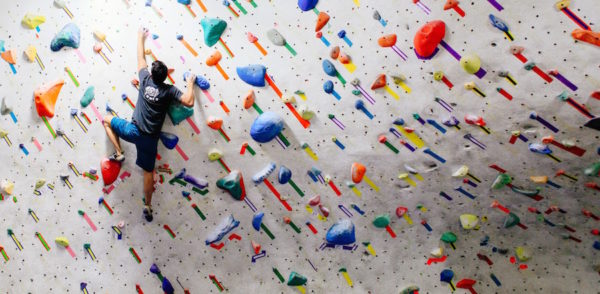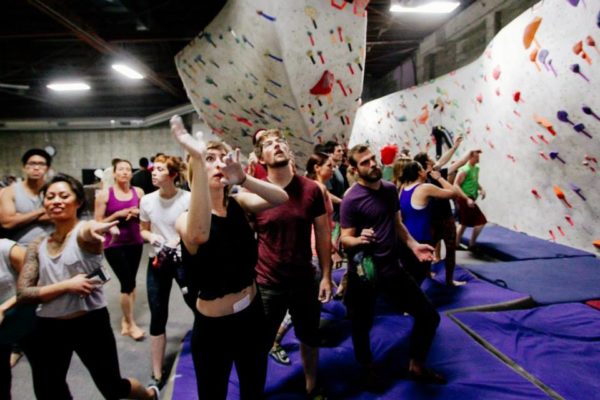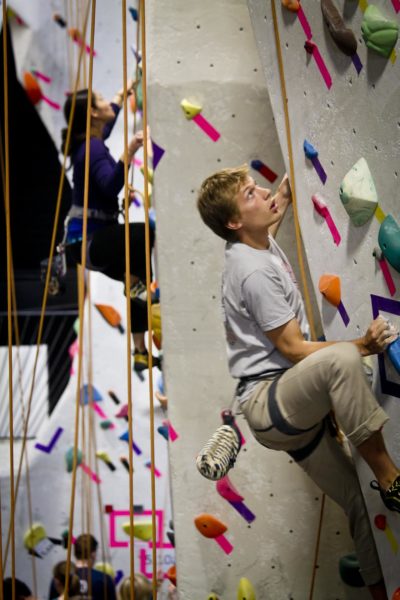It’s 9 o’clock on an unremarkable Tuesday night at The Studio. The influx of eager climbers has slowed, creating somewhat of a lull for us at the front desk. I take advantage of our brief reprieve and address some of the closing chores, namely taking out the trash.

I’ve learned from unpleasant experience not to look too closely at the contents of the garbage; I usually try to enter a state of dissociative amnesia while I’m running trash. If I’m lucky, I don’t even remember doing it once I’m done. On this night, however, I was pulled back into reality when I inspected the bottom of a trash can and found, crumpled and reduced to refuse, all of the grades from the routes that had been stripped the day before.
I blinked. Stripped less than a day ago, the shiny duct tape had already begun to lose its luster. Numbers corresponding to the Yosemite Decimal System were decimated, wadded up and discarded like a piece of gum that’s lost its flavor. The 5.12+ that had looked so imposing adhered to the lead wall now lay in a puddle of coffee, drowning sorrowfully next to a 5.11 that I had called soft. The routes which had supposedly been the measure of our climbing abilities were now little more than a piece of yesterday’s trash.
 Maybe you’re starting to see where I’m going with this. Grades have become an inexorable aspect of the climbing gym experience, and for many, they have become the main reason to go to the gym or to climb at all.
Maybe you’re starting to see where I’m going with this. Grades have become an inexorable aspect of the climbing gym experience, and for many, they have become the main reason to go to the gym or to climb at all.
It’s not hard to see why this happens. Climbing media spotlights elite climbers sending the world’s hardest, most exciting climbs, leaving us drooling over the send footage and devising plans to be that strong some day. When your hero is some dude doing one-finger pull-ups and climbing V15, the value judgement you make is about measurable criteria: what grade he climbs and how many one-arms he can do, not something vague like how much fun he is having.
Maybe you come to the gym and train so you can be that guy, or so you can be the girl on the cover of the next climbing magazine, and that’s fine.
No, really, that’s awesome, I want to be that guy too.
However, I don’t think achieving that success should come at the price of losing perspective of why we go to the climbing gym. I think many of us (including myself) could use a critical reevaluation of what a grade in the gym means, or at least what it should mean. A grade in the gym is a suggestion, a tentative guideline based on a general consensus to help you find something that you want to climb. A grade is little more than an instrument for helping you select a route to train on; in the gym, grades are stripped of whatever intrinsic value they might have outdoors. Here’s what a 5.10a in a gym really means:
5.10a: If you climb 5.10, you should try this, and it will be moderately challenging. If you climb 5.12, you could use this as a warm up, or to run laps. If you climb 5.9, you should project this, if you feel like trying hard.
 We recently hosted a youth SCS competition at The Studio where the comp climbs weren’t labelled with YDS grades. Instead, they were numbered from 1-40, with 1 being the easiest and 40 being the hardest. For a brief, magical period after the competition (before the routes got YDS grades), people had the opportunity to get on a climb without any preconceived notion of how hard it “should be.” And while some people took this opportunity, others couldn’t stand the idea of not knowing the “real grade” of the climb, i.e. what that climb was worth to them, and others, in terms of bragging rights and send-points. If you want to know what those climbs, or any climb in the gym is really worth, I’ll tell you: They’re worth whatever training you got out of trying them, and whatever fun you had while climbing them.
We recently hosted a youth SCS competition at The Studio where the comp climbs weren’t labelled with YDS grades. Instead, they were numbered from 1-40, with 1 being the easiest and 40 being the hardest. For a brief, magical period after the competition (before the routes got YDS grades), people had the opportunity to get on a climb without any preconceived notion of how hard it “should be.” And while some people took this opportunity, others couldn’t stand the idea of not knowing the “real grade” of the climb, i.e. what that climb was worth to them, and others, in terms of bragging rights and send-points. If you want to know what those climbs, or any climb in the gym is really worth, I’ll tell you: They’re worth whatever training you got out of trying them, and whatever fun you had while climbing them.
I’m not suggesting that we do away with the entire concept of grading in the gym, far from it. We all use grades to determine what to warm-up on, what to project, and to get an idea of what we could (ideally) climb outside. However, we should all notice that the girl on the front of the climbing magazine isn’t pictured inside a climbing gym, she’s outside doing what she spent all those hours in the gym training to do: real climbing. World-ranked climbers aren’t logging their gym climbs on their 8a.nu, and neither are you, so don’t beat yourself up when you don’t send your gym project.
By no means am I trying to diminish the joy we experience when we send a project in the gym, rather, I hope we can all realize that the pleasure we derive from our time in the gym is not contained in the number at the bottom of the route. Whatever your project in the gym may be, you can rest assured that it won’t be there for long. What will last, however, is the enjoyment you derive from it, and the positive effect it has on your climbing. Six months from now when you’re climbing outside and reaping the benefits of the training you’re doing now, you will benefit from the overall work you put in, not the V-points you earned in the gym. As for the ratings of your training routes? You won’t remember them any more than you remember the contents of yesterday’s trash.
By Zach Wright. Zach is the Head Coach for Team Touchstone and can be found coaching at Touchstone Gyms in the Bay Area.

